Most Commonly Repaired Stair Parts for a Stair Remodel or Project
There are a few things that you should look for when you're trying to get a handle on the wear and tear that your stairs are sure to endure over the years.
The first step is identifying the problem.

There are a number of difficulties that you can experience when dealing with stair parts and repairs. These problems can come in all shapes and sizes and can range from creaky steps, loose iron balusters, to damaged railings. The first step in the restoration or upkeep of your staircase will be to access the problem. This can be accomplished by traveling your staircase and listening for squeaks and feeling for loose steps. Once you’ve pinpointed a problem, you should visually inspect the area, looking for gaps or other signs of wear.
The Most Common Repairs
Whether you are undergoing a stair remodel or just practicing routine maintenance, there are issues that are sure to arise. The most common of these issues are usually loose stringers and squeaky stair risers or treads.
Loose Stingers. If you are unfamiliar with stringers, they are the diagonal stair parts that abut the risers and treads on a staircase. Stingers tend to spread apart over time due to poor original workmanship, inappropriate repair, or most often, because of wall movement called house settling. When this occurs, risers and treads become loose and begin pulling from their housings. The process of repairing this issue can be easy to accomplish with the proper guidance and expertise.
Squeaky Stairs. Of all the issues that you can intend to find, the most frequent will be squeaky stair risers or treads. Typically, stair risers and treads aren’t nailed down. It is common practice to use wedges instead in an attempt secure these stair parts while keeping them squeak-free. When squeaking does arise, it is usually because these wedges have become loose. Of all of the repairs that you are sure to undergo, this is usually the most simple. By re-tightening and securing the wedges, the squeaking should subside, and you’ll be on to the next project in no time at all.
Whether you’re dealing with iron balusters, loose stingers, or just a few squeaky steps, it is always helpful to have an expert on your side during any stair remodel or repair project. Direct Stair Parts has the resources you need for any stair project, including detailed diagrams, a stair parts specification guide, and best of all, the most premiere stair parts at the best prices. Contact us today so that we can answer your questions and help you find the quality stair parts that you need.
- Aly Curtis
- Tags: iron balusters stair parts stair remodel
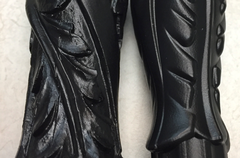
Aren't all Iron Balusters the same?
 When it comes to buying stair parts, how do you weed through all of the myriad of products, prices, online stores, etc?
When it comes to buying stair parts, how do you weed through all of the myriad of products, prices, online stores, etc?
Aren't they all pretty much the same?
They all look pretty much the same from website to website but the prices often vary slightly. How do you decide who to trust and what to avoid?
The reality is that not all stair parts are created equal. Despite images online looking very similar, once you hold them in your hand or are walkign up the stairs next to them, you will be able to see the difference. Let's face it, in most scenarios, the staircase is often a central piece in the house. A staircase can create continuity and flow or can simply look like a necessary chunk of utility. Choosing the right stair parts can make the difference between the two.
It is my job to know the difference between the many options and to ensure that my clients receive only the highest quality products available. In all of my time working with stair parts I have com in contact with the balusters of many different manufacturers and I have found 3 key differences that separate the good from the mediocre from the bad.
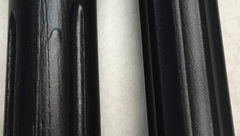 1. Finish Quality. In "most" cases, iron balusters are powder coated however not all materials used in the powder coating process are the same. In the same way that paint quality varies, the quality of powder coating can vary greatly. Cheaper stair parts will use a grittier powder coating which gives the baluster a less refined, bumpy and inconsistent finish. Higher quality parts use higher quality powder coating which makes the baluster seem like the iron and the paint are one and the same piece.
1. Finish Quality. In "most" cases, iron balusters are powder coated however not all materials used in the powder coating process are the same. In the same way that paint quality varies, the quality of powder coating can vary greatly. Cheaper stair parts will use a grittier powder coating which gives the baluster a less refined, bumpy and inconsistent finish. Higher quality parts use higher quality powder coating which makes the baluster seem like the iron and the paint are one and the same piece.
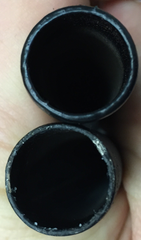 2. Metal thickness / quality. Simply put, cheap baluster manufacturers try to cut corners wherever they can and this means putting less material into their product. You can hold the same design baluster by two different manufacturers and with your eyes closed be able to tell which is good and which is not quite there. The material used in quality balusters simply feels more solid (because it is)
2. Metal thickness / quality. Simply put, cheap baluster manufacturers try to cut corners wherever they can and this means putting less material into their product. You can hold the same design baluster by two different manufacturers and with your eyes closed be able to tell which is good and which is not quite there. The material used in quality balusters simply feels more solid (because it is)
 3. Design quality. Baluster designs do not vary much from one manufacturer to another. Everyone has the same basic designs that they sell based on what the market demand looks like. This is truly a case of the devil being in the detail. Cheap stair parts do not take the time to manufacture refined products. While the differences might be subtle when comparing simple designs, once you begin to compare more complex craftsmanship, the higher quality balusters will really separate from the cheap.
3. Design quality. Baluster designs do not vary much from one manufacturer to another. Everyone has the same basic designs that they sell based on what the market demand looks like. This is truly a case of the devil being in the detail. Cheap stair parts do not take the time to manufacture refined products. While the differences might be subtle when comparing simple designs, once you begin to compare more complex craftsmanship, the higher quality balusters will really separate from the cheap.
So how do I buy the right ones when all I have to go on is the pictures and prices?
Sadly, you would think that cheaper balusters would simply cost less but that isn't always the case. What you can count on is brand. I will not point a finger at balusters that in my opinion are a lower quality product but I will speak to three manufacturers that produce high quality products and that you can count on.
1. WM Coffman
2. LJ Smith
3. Walnut Creek
These three manufacturers have set the bar in the industry and they always deliver the highest quality products be it iron or wood, these are three brands that you can count on.
- Joshua Swenson
Your First Stair Re-model - DIY
Wrought Iron Stair Baluster Installation is Easy!!!
Preparation is Key!

Preparing your stairs for wrought iron baluster installation is easy. The purpose of this step is to protect the rest of your stairs as well as your furniture. Stair installations will be much smoother without the furniture and wall repairs later.
-
Cover any nearby furniture with 3mil plastic sheathing.
-
Remove anything from the walls adjacent to stairs so that they are not accidentally knocked off.
-
Prepare your workspace and needed tools. Tools you will need include :
-
Utility knife, pry bar, Saws All, Band Saw, Sander or Sand Paper, Drill and bits, Tape measure, Level, Balusters, Newel posts (if replacing), Handrail (if replacing), Fittings, Hardware, Screws, Stain, Paint, Polyurethane, Finishing nails (for wood).
-
Blog Post for this month:
When discussing stair installations with both your salesperson and installer, it is important to be on the same page in regards to the terminology involved. Don’t worry, though, this is very easy. There are only a few you need to worry about. Here is your primer on Stair Parts and Stair Installation terminology.
Stair Parts Glossary:
Baluster/Spindle - the vertical member, plain or decorative,
that acts as the infill between the handrail and baserail.
Balustrading - the collective name for the complete assembly
of handrails, baserails, newels, spindles and caps.
Bullnose Step - usually at the bottom of the stairs with one or
both ends of the step having a quarter circle design.
Closed String - a string with the face housed/trenched to
accommodate treads and risers so their profile cannot be seen.
Continuous Handrail - using straight lengths of handrail
connected to handrail fittings and ramps, the handrail flows over
the tops of newel turnings creating a continuous run of handrail.
Cut or Open String - a string with the upper edge cut away
to the shape of the treads and risers so that their profile can be
seen from the side.
Going - the going of a flight of stairs is the horizontal distance
between the face of the first and last risers. The individual
going of a step is measured from face of riser to face of riser
Newel - accommodates the balusters, handrails and treads/risers.
Nosing - the edge of the tread projecting beyond the face of
the riser and the face of a cut string.
Pitch - the angle between the pitch line and the horizontal.
Pitch Line - the notional line connecting the nosings of all
treads in a flight of stairs.
Rake - the pitch of the stairs.
Rise - the rise of a flight is the vertical distance between the
floors or landings connected by the flight. The individual rise is
the vertical measurement from top of tread to top of tread.
Riser - the board that forms the face of the step.
Staircase - the entire structure relating to a stair, comprising
steps, treads, risers, strings, balustrading, balusters, landings etc.
Stairway/Stairwell - the space/void provided for the stairs.
Step - the tread and riser combined.
String Margin - the distance between the top of the string
and the pitch line measured at 90° to the pitch line.
Tread - the top or horizontal surface of a step.
Wall String - the string of a staircase fixed flush with a wall.
Winders - are radiating steps narrower at one end that are
used to change the direction of a stairs through 90° or 180°.
Product Showcase:
Box Newel
Want to make a grand entrance to your home? The box newel is the perfect choice. It comes in flat panel, raised panel, recessed panel, and fluted to fit a variety of decors. From the 4” wide to 7 ½” wide a box newel will fit any application. A box newel will also help separate you from your neighbors and is the fastest growing newel style. Inquire about box newels today (make hot the last statement to a link to box newels landing page).
Money Saving Idea:
Want the look of hardwood treads with a carpet runner but don’t want to spend the high dollars on a full tread installation? Then look at the 8071/8072 false treads and risers in Red Oak. They go where your existing paint grade cap and rise are and give you the look of full treads and carpet runner at about half the price, saving you $1,500 to $2,00.00 on parts and installation. And they are a snap to install, many times going right back in place of your existing cap and rise with minimal cutting and fitting.
Specials:
Maple Box Newels, 7 in stock for 75% off, sale price is $65.00 each
What To Buy Guide:
When ordering parts, make sure you have all you need to complete your installation.
When purchasing balusters, you will need the balusters, base shoes (flat for balconies open stringer rakes, and angled for closed stringer rakes), under mount shoes (optional, flat shoes for balconies and angled shoes for rakes, make sure they have a set screw). You will also need epoxy and an epoxy gun to glue them in.
When purchasing handrail, please be sure if you are attempting to match any existing rail or fittings that you know the profile and dimensions of your current system. Also, when buying all new, be sure that your fitting profiles match the handrail profile designations. All of our descriptions and photo guides with help you with this. You will need rail bolts (typically included with fittings), wood glue and clamps to complete installation. Installation guides and templates are also normally included with the fittings.
When purchasing newels, you will need to know if you want to go with a post to post system or over the post system. With post to post systems you will need to buy a long face newel for landings and short face newels for starting sections and balcony intermediates. If you want to use all short face newels then you will need to utilize goosenecks for the landing to rake transitions. You will need sure-tite newel fasteners to anchor the newels. On post to post systems be sure to order the appropriate fittings to complete the installation.
When purchasing treads, measure from the wall to the outside of the stairs and order at least two inched longer to ensure proper trim and fit. On stairs that are open both sides, you will order a plain bullnose tread 2” deeper and 4” longer than the outside to outside measurement, and the returns will be done on site from the additional wood at the back of the tread. Liquid nails should be used in lieu of nails for a cleaner installation. Many types of mouldings are available to trim out your installation, but will be required for covering joints. Riser material can be cut from MDF, Oak, or Plywood depending on if you want stain or paint grade installation.
- Bill Vickers
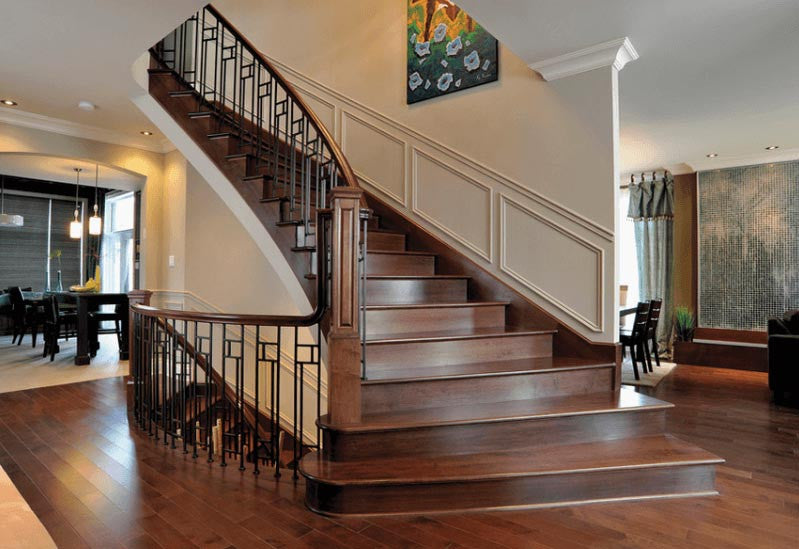
This Year's Best Staircase Trends
Every year new trends emerge in the stair parts marketplace. It usually takes a few years for them to pick up steam, but once they do, you'll see it in stair remodels everywhere. Whether you prefer a classic stair design or a more modern staircase, the trends of of the year have a unique combination of the two.
Unique Iron Balusters

Iron balusters have been trending for years, but these unique designs have started to show up in stair parts shops all over the country. You can now find iron balusters with geometric shapes, arches, and various other lovely designs.
Dark Treads

Wood stairs are as classic as you can get, so it's not surprising that a new spin on this classic preference has come to the light. Designers are beginning to use darker stains and woods to give treads a striking elegance.
Natural, Eco-Friendly Wood Stairs

Going green seems to be the trendy thing to do in 2016, and staircase design is no exception. Designers have started to source wood stairs that are free of chemicals from local distributors for a more eco-friendly approach.
Minimal Staircases

The Tiny Home Movement has sparked the consumer's desire for less in their homes. And with less square footage, the more minimal the staircase, the better. Spiral staircases, staircases with stair railings, and other variations are very trendy right now.
- Bill Vickers
- Tags: iron balusters stair design stair parts stair railings stair remodel wood stairs
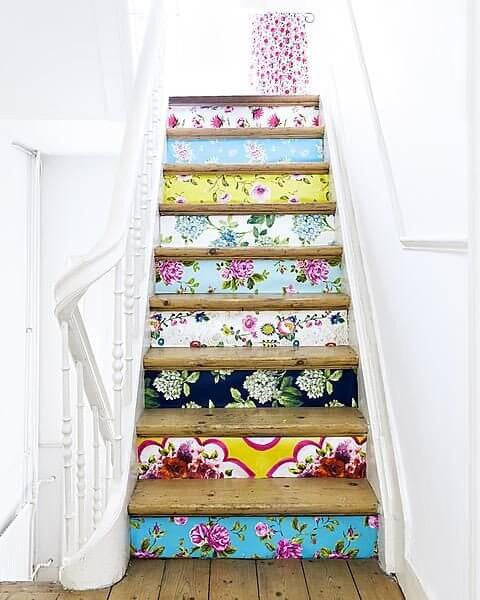
Spring Decorating Ideas for Your Staircase
It's warming up outside and colorful flowers are coming in, springtime is definitely in the air. Spring cleaning has commenced, and bright decorations are popping up everywhere you look. If the decor in your home is going to shift for spring, don't ignore one of the most visible places in it: your staircase.
Instead, let your staircase steal the show with some beautiful spring decor. Here are a few of our favorite ideas for the season.

1. Add a springtime wrap to your handrail. Go to your favorite craft store, pick up about 15-20 feet of your favorite floral line, and wrap it around your stair railings. You can even experiment by adding the floral line to other stair parts like your iron balusters.
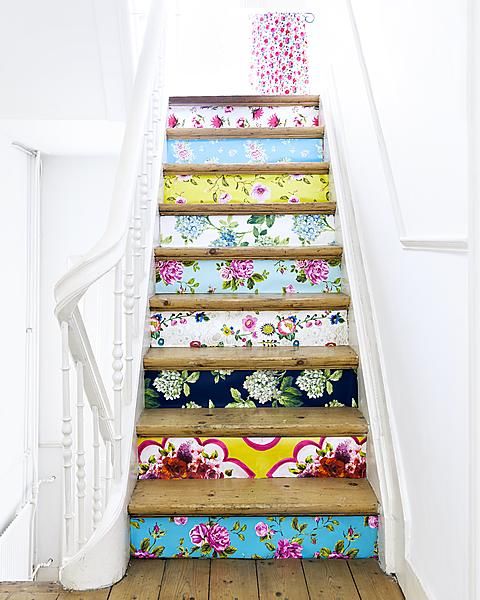
2. Add brightly colored, temporary wallpaper to your risers. You don't have to adjust your permanent stair design to play with this colorful addition. Simply purchase a few different springtime wallpaper designs and get started.

3. Create a springtime collage on the wall. Although this might be the most expensive idea, it is definitely a stunning one. Start by collecting images that are in line with your theme, buy matching frames for each images (or mismatch them, either way!), and get hanging! You'll love the updated look this springtime decor adds to your staircase.
- Bill Vickers
- Tags: iron balusters stair design stair parts stair railings
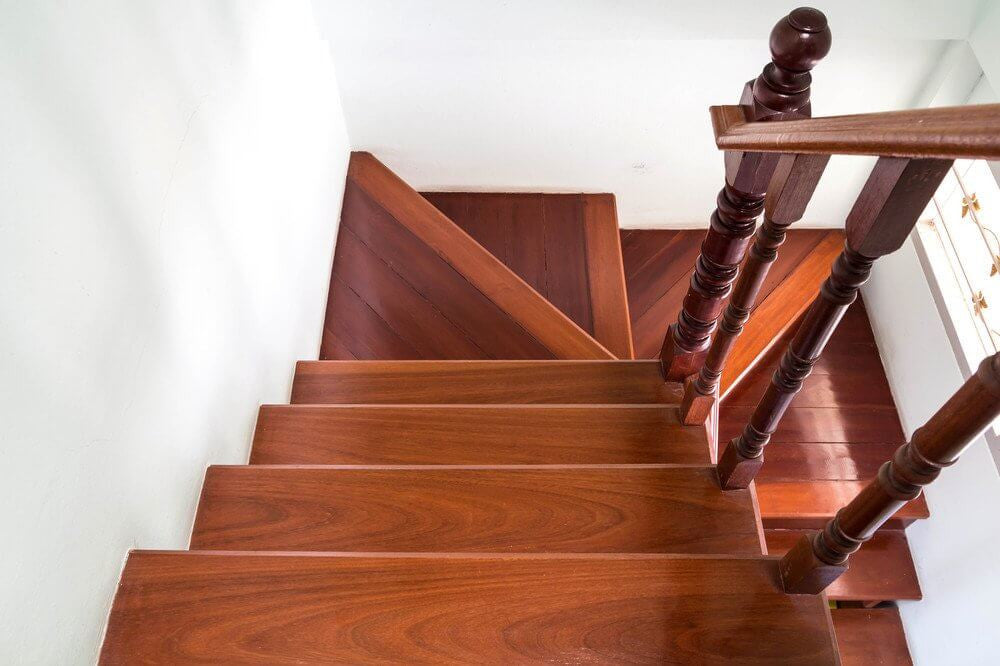
How to Make Your Wood Stairs Less Slippery
Everyone loves a classic, wooden staircase. Not only do wood stairs give a timeless look to a stair remodel, but they're easy to keep clean. Unfortunately, installing wood treads can come at a price: a slippery staircase. The good news is that there are things you can do to prevent this from being the case.
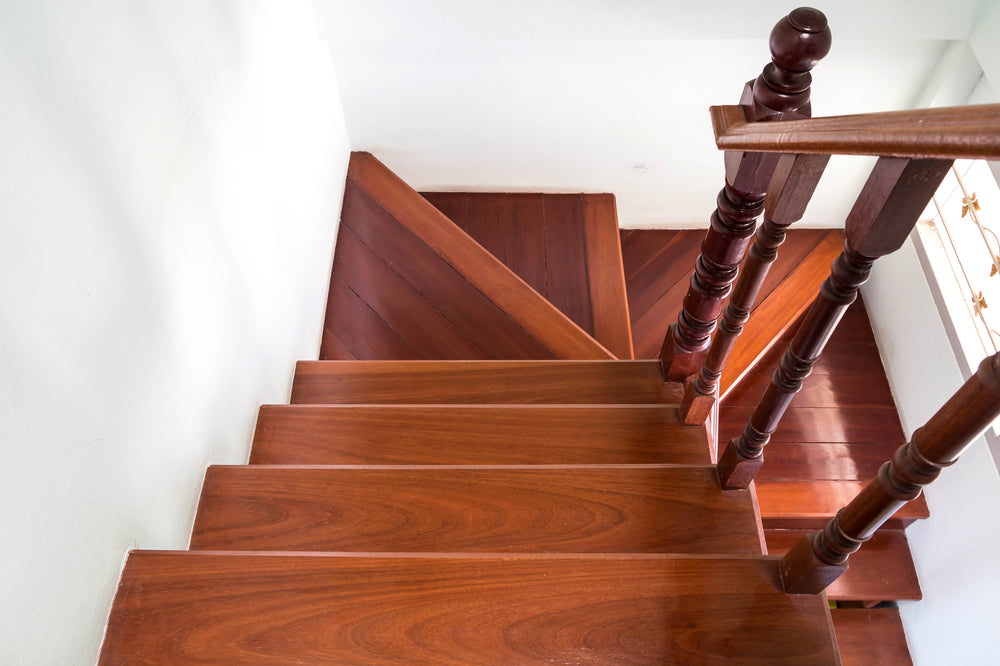
The first option for slippery wood stairs is carpeting.
Runners are good for adding a bit of luxury to any staircase, but keep in mind that if your treads are narrow, the carpeting might end up causing an even bigger hazard. Unsupported carpet at the edge of each tread could cause someone to slip. If this is the case on your wood stairs, you can also buy individual carpeting for each stair.
A coat of anti-slip paint is also an option.
You probably had no idea that you could add a layer of non-slip paint to each tread to prevent slips. This kind of paint can be found in hardware stores or online. It can be purchased in a variety of colors or as a clear coat, whichever you prefer for your staircase.
You can install a No-Slip strip.
There are a variety of adhesive strips that you can apply to your staircase to make it less slippery. The No-Slip Strip is a great option that's easy to install. They're comfortable on your feet and durable so that they can last for years to come.
Before you decide on any of the options above, be sure to check the level on each of your individual treads to make sure that none of them are slanting forward. This is a common issue that causes wood stairs to be more slippery, so if your stairs are slanting forward, you might have to consider installing new ones. You can find stair parts and everything you need for a stair remodel or project on our website. Be sure and connect with us on Google Plus.
- Bill Vickers
- Tags: cheap stair parts stair parts stair railings stair remodel wood stairs




